Upwards movement continues as expected. A downwards whipsaw breached the invalidation point on the hourly chart, which was too close.
Summary: The target is 1,277. Use the blue Elliott channel on the daily and hourly charts to indicate when price has turned. Expect more upwards movement while price remains within the channel.
Look out for strong resistance ahead at the upper maroon trend line on the main weekly and daily charts.
Always use a stop. Invest only 1-5% of equity on any one trade.
New updates to this analysis are in bold.
Last monthly charts and alternate weekly charts are here, video is here.
Grand SuperCycle analysis is here.
MAIN ELLIOTT WAVE COUNT
WEEKLY CHART
The Magee bear market trend line is added to the weekly charts. This cyan line is drawn from the all time high for Gold on the 6th of September, 2011, to the first major swing high within the following bear market on the 5th of October, 2012. This line should provide strong resistance.
At this stage, a triangle still looks possible and has the best fit for cycle wave b. It has some support from declining ATR and MACD now beginning to hover about zero.
Within a triangle, one sub-wave should be a more complicated multiple, which may be primary wave C. This is the most common sub-wave of the triangle to subdivide into a multiple.
Primary wave D of a contracting triangle may not move beyond the end of primary wave B below 1,123.08. Contracting triangles are the most common variety.
Primary wave D of a barrier triangle should end about the same level as primary wave B at 1,123.08, so that the B-D trend line remains essentially flat. This involves some subjectivity; price may move slightly below 1,123.08 and the triangle wave count may remain valid. This is the only Elliott wave rule which is not black and white.
Triangles normally adhere very well to their trend lines. So far the A-C trend line has been tested 11 times; this line has very strong technical significance. If this wave count is correct, then intermediate wave (B) should find very strong resistance if it gets up to the A-C trend line. A small overshoot is acceptable. A breach is not. If price reaches up to that trend line in the next one to few days, it would offer a good entry point for a short position. Stops then may be set a little above the line, or just above the invalidation point.
Finally, primary wave E of a contracting or barrier triangle may not move beyond the end of primary wave C above 1,295.65. Primary wave E would most likely fall short of the A-C trend line. But if it does not end there, then it can slightly overshoot that trend line.
Primary wave A lasted 31 weeks, primary wave B lasted 23 weeks, and primary wave C may have been complete in 25 weeks.
Primary wave D should now be expected to last a Fibonacci 13 or 21 weeks in total.
DAILY CHART
A common range for triangle sub-waves is from about 0.8 to 0.85 the prior sub-wave, this gives a range for primary wave D from 1,158 to 1,149.
At this stage, to try and see the whole of primary wave D complete at the last low does not look right. The B-D trend line would be too steep for a normal looking contracting Elliott wave triangle, and primary wave D would have been far too brief at only 5 weeks duration. For the wave count to have the right look and good proportions (as Gold almost always does), primary wave D should not be labelled over yet.
If primary wave C is correctly labelled as a double zigzag, then primary wave D must be a simple A-B-C structure and would most likely be a zigzag.
With intermediate wave (A) complete and now intermediate wave (B) a large and deep correction, primary wave D is beginning to look very typically like a large exaggerated zigzag.
Intermediate wave (B) looks to be unfolding as a zigzag, a three wave structure. Corrective waves have a count of 3, 7, 11, 15 etc. Each extension adds another 4. So far intermediate wave (B) has a count of 10 on the daily chart, so it now again looks incomplete.
Draw an Elliott channel about the zigzag of intermediate wave (B). Use this as a guide to when it may be over. When price breaks below the lower edge, that may be taken as an indication of a trend change.
So far intermediate wave (B) has lasted 16 days. It may not exhibit a Fibonacci duration now if it ends below the maroon A-C trend line.
Within the zigzag of primary wave D, intermediate wave (B) may not move beyond the start of intermediate wave (A) above 1,295.65.
HOURLY CHART
It looks like minor wave C is extending. Within minor wave C, minute wave ii shows up on the daily chart as one red daily candlestick. So for the structure to have the right look at the daily chart level minute wave iv may also show up as one or more red daily candlesticks or doji.
The downwards whipsaw during Tuesday’s session could not be minute wave iv as it overlapped back into minute wave i price territory. This may be minuette wave (iv). Minute wave iii may have ended at Tuesday’s high.
An ending diagonal for minor wave C does not work. The diagonal would be contracting, but the trend lines would diverge breaking an Elliott wave rule. It is my conclusion that minor wave C is still unfolding as an impulse and the structure is incomplete.
ALTERNATE ELLIOTT WAVE COUNT
WEEKLY CHART
This wave count has been published only in historical analysis. At this stage, it will be published on a daily basis.
There are more than 23 possible corrective structures that B waves may take, and although cycle wave b fits best at this stage as a triangle (main wave count), it may still be another structure. This wave count looks at the possibility that it may be a double zigzag.
If cycle wave b is a double zigzag, then current upwards movement may be part of the second zigzag in the double, labelled primary wave Y.
The biggest problem with this wave count is the structure of intermediate wave (A) within primary wave Y. This upwards wave looks very much like a three and not a five. This upwards wave must be seen as a five for this wave count to work.
Within the second zigzag of primary wave Y, intermediate wave (B) is a completed regular flat correction. Minor wave C ends just slightly below the end of minor wave A avoiding a truncation. There is no Fibonacci ratio between minor waves A and C.
The target remains the same as previously published for this wave count.
Along the way up, some resistance should be expected at the cyan Magee trend line.
Within intermediate wave (C), no second wave correction may move beyond the start of its first wave below 1,205.41.
DAILY CHART
Intermediate wave (C) may be unfolding as an impulse.
Minor wave 2 may be over as a very quick and shallow zigzag.
Because minor wave 1 was a long extension, the target for minor wave 3 is for equality with minor wave 1.
Within minor wave 3, no second wave correction may move beyond the start of its first wave below 1,244.01.
HOURLY CHART
If minor wave 3 for this alternate is to be an extension reaching equality with minor wave 1, then its subdivisions may show up on the daily chart like those for minor wave 1 do.
This wave count would now expect a strong increase in upwards momentum as the middle of a third wave passes. It is now quite concerning that momentum has not increased and is showing a strong decline. This does not support this wave count today.
Minuette wave (ii) may not move beyond the start of minuette wave (i) below 1,255.16.
TECHNICAL ANALYSIS
WEEKLY CHART
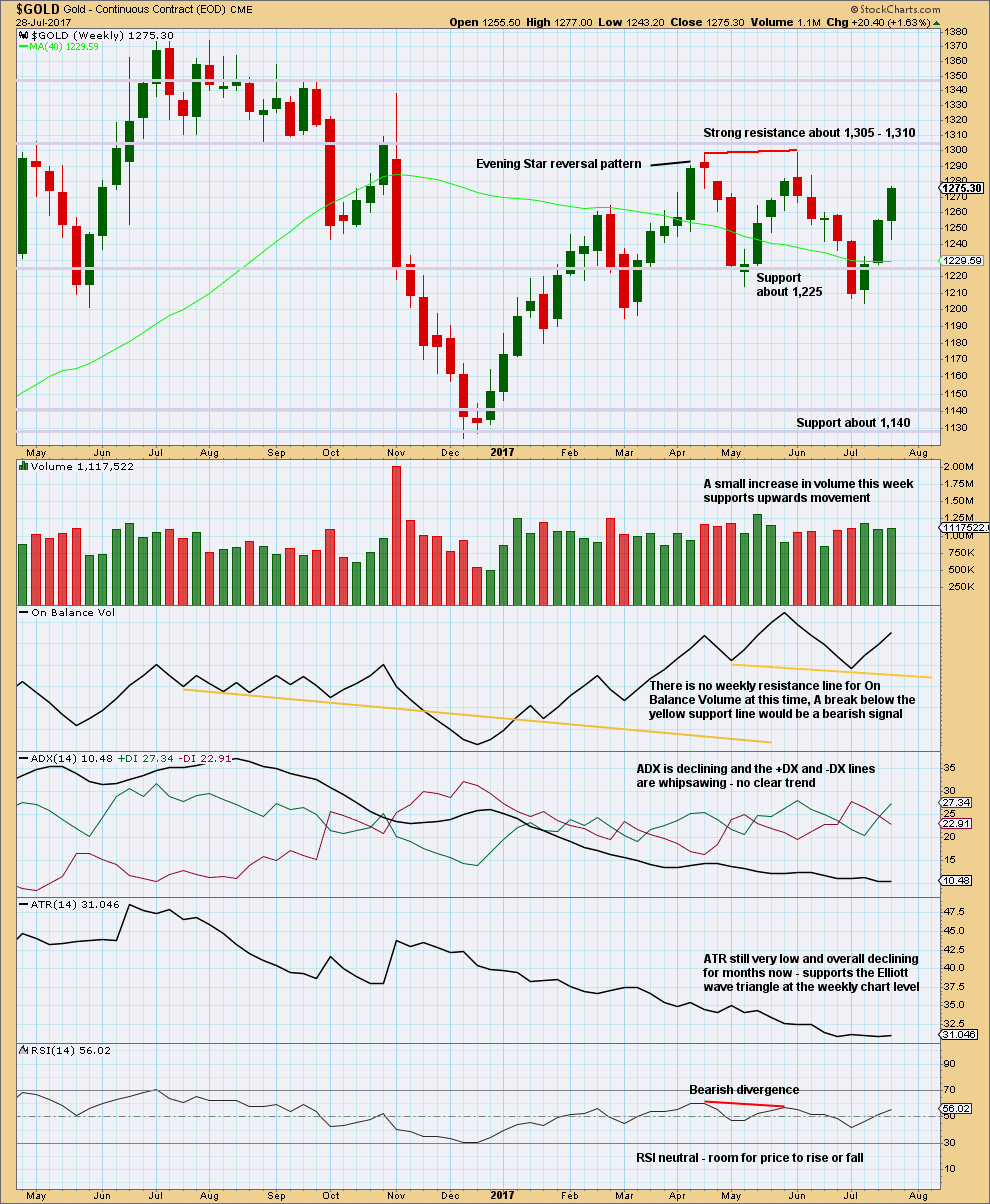
Click chart to enlarge. Chart courtesy of StockCharts.com.
A long lower wick and some support from volume suggest more upwards movement this week.
Price is range bound with resistance about 1,305 to 1,310 and support about 1,225 to 1,205. During this range bound period, it is an upwards week that has strongest volume suggesting an upwards breakout may be more likely than downwards. This is contrary to the main Elliott wave count.
ATR continues to decline, which does support the main Elliott wave count.
DAILY CHART

Click chart to enlarge. Chart courtesy of StockCharts.com.
Stepping back and looking at the larger consolidation, Gold moved into a range back in February this year, delineated by support and resistance zones. During this consolidation, it is two upwards days of 7th of April and the 17th of May that have strongest volume. This suggests an upwards breakout is more likely than downwards, and it supports the alternate Elliott wave count and not the main Elliott wave count.
A long lower wick and some support from volume today is bullish. The trend remains up.
GDX
DAILY CHART
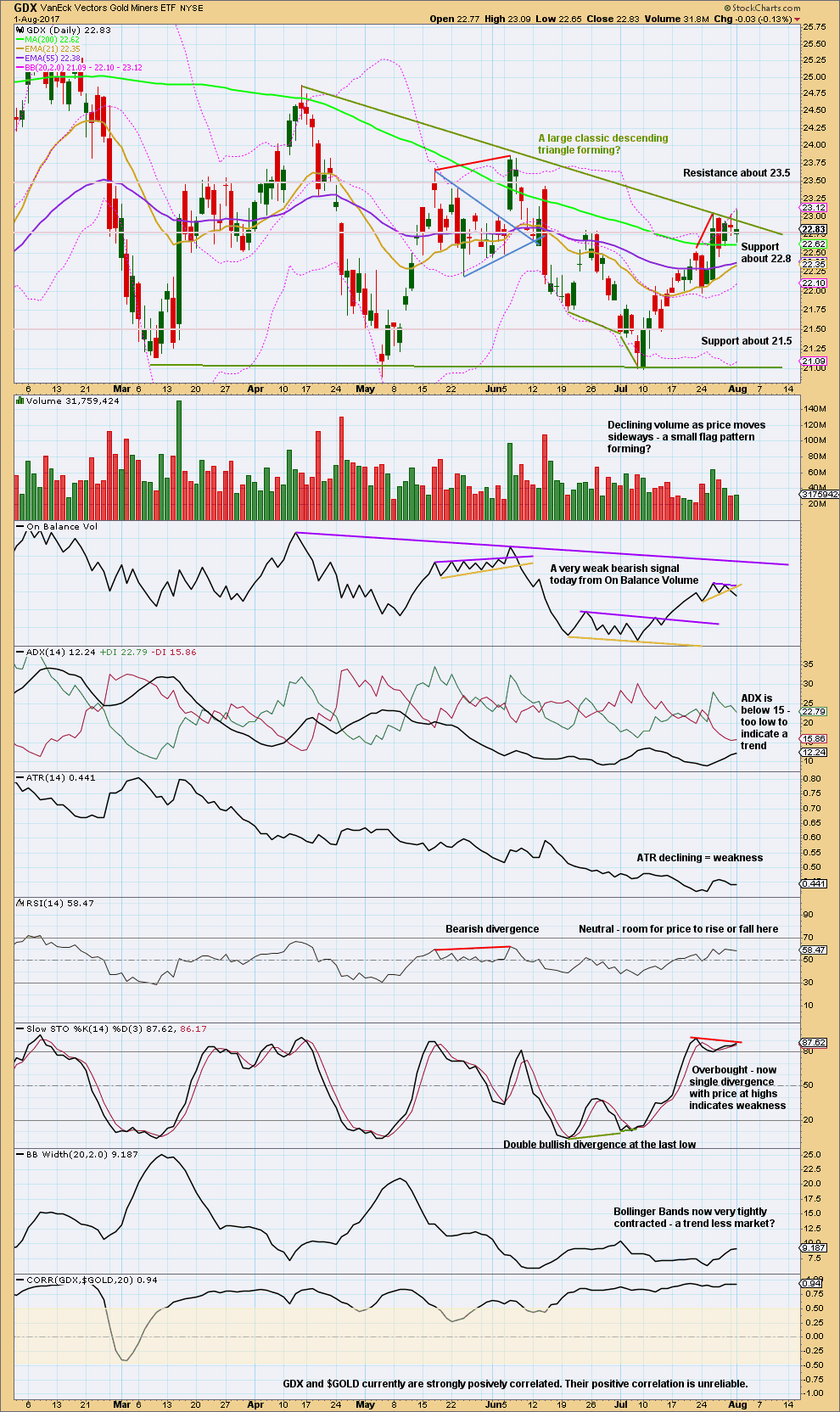
Click chart to enlarge. Chart courtesy of StockCharts.com.
Stepping back for GDX too, to look at the past six months, a large descending triangle looks like it has formed and may be close to a breakout. Breakouts from descending triangles are usually downwards.
During this structure though it is an upwards day for the 15th of March that has strongest volume suggesting an upwards breakout may be more likely than downwards.
There is overall some decline in volume lately. This supports the view that a triangle is nearing completion. ATR also supports this view.
The last few sessions look like a small flag pattern may be forming. Flags are reliable continuation patterns, so the breakout would be expected to be upwards.
Published @ 06:16 p.m. EST.

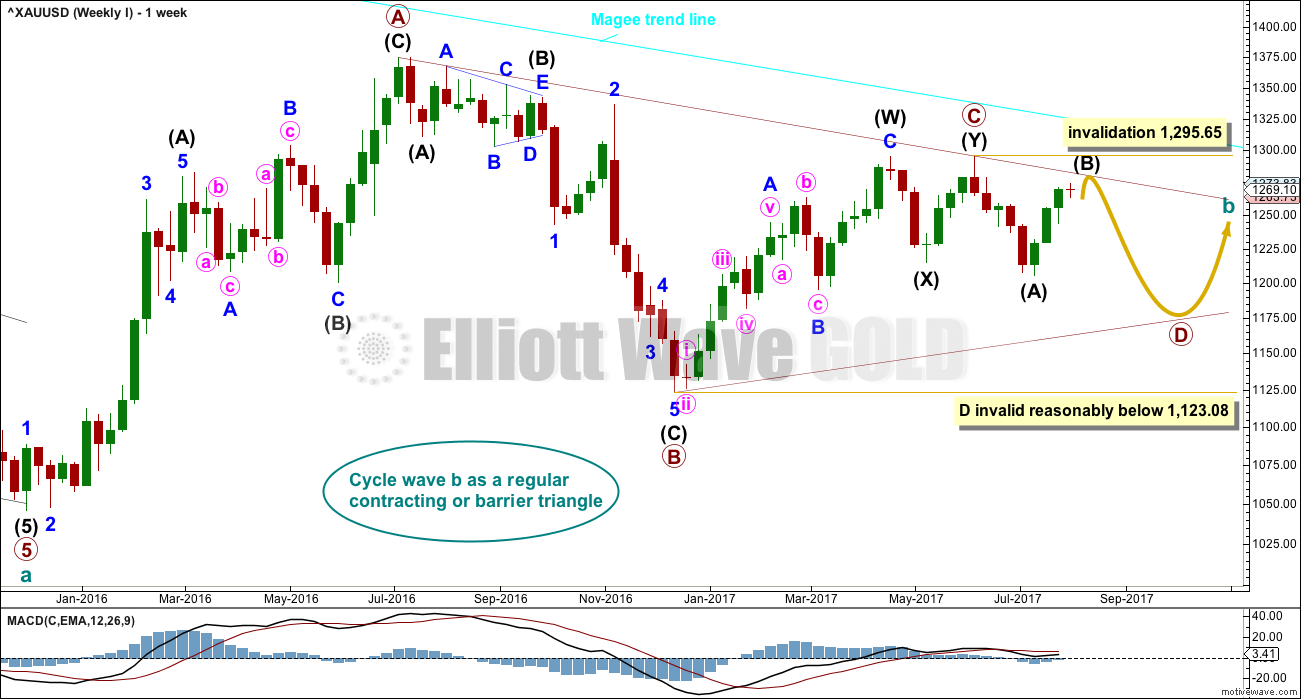
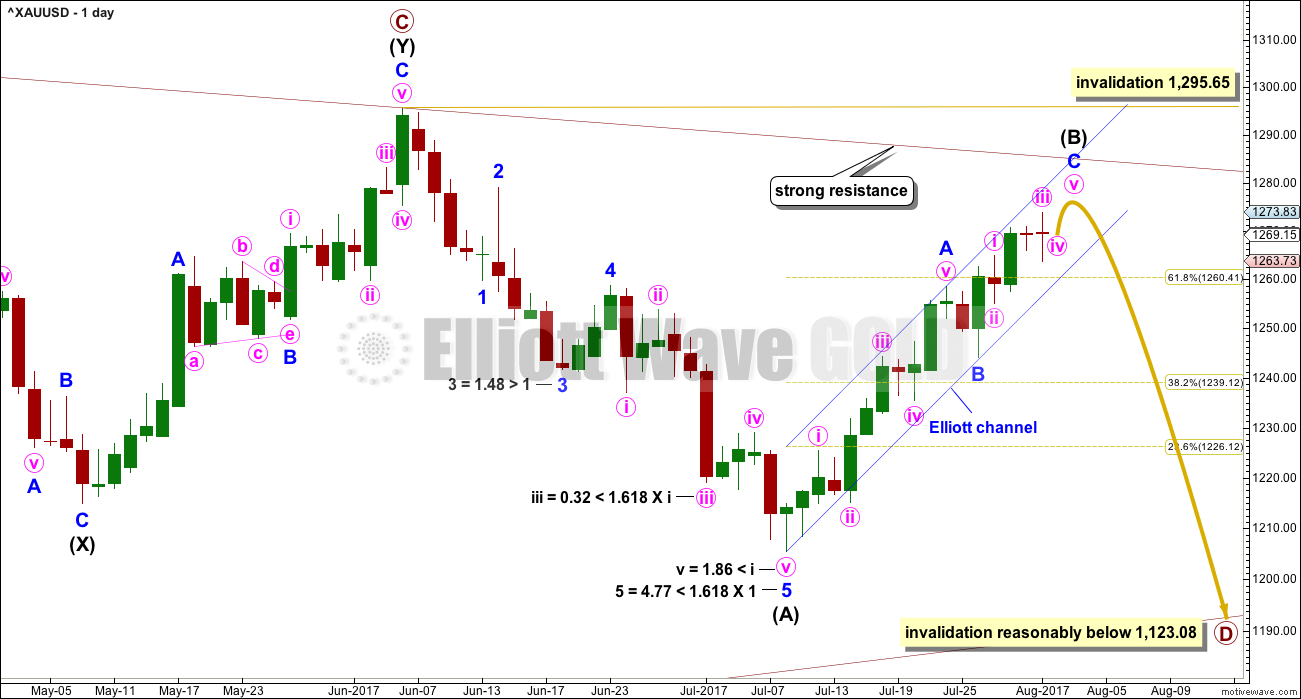
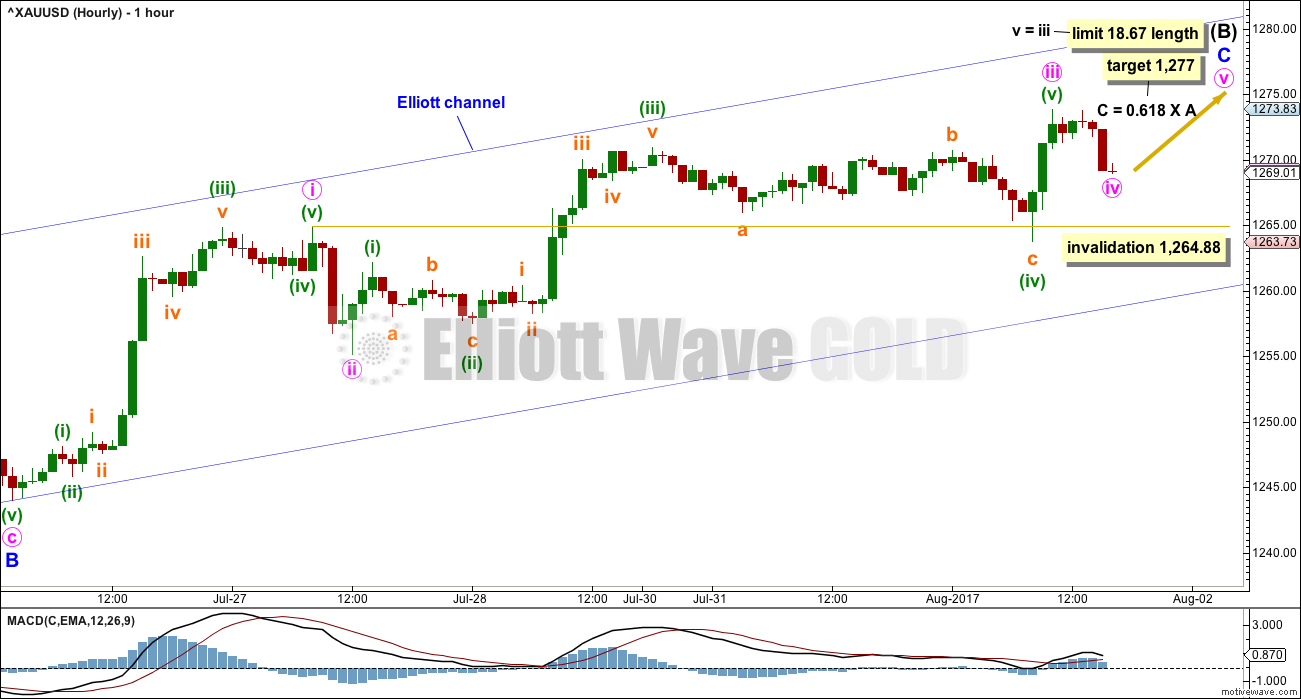
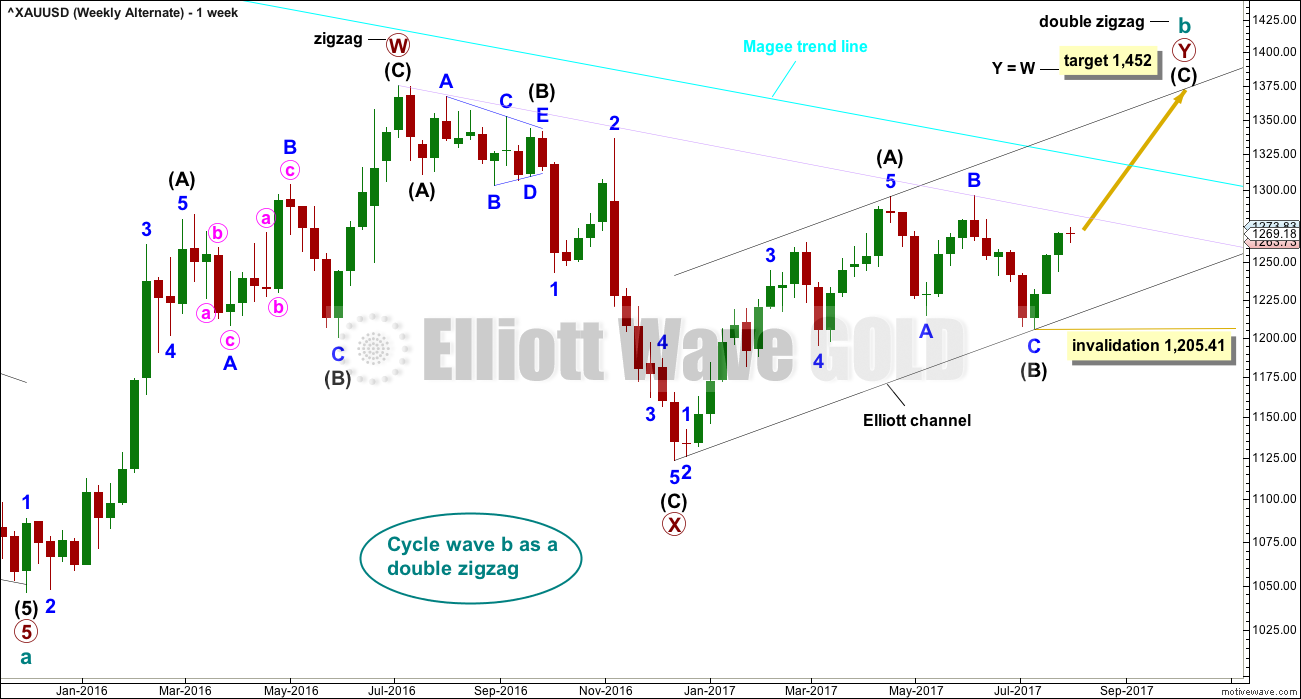
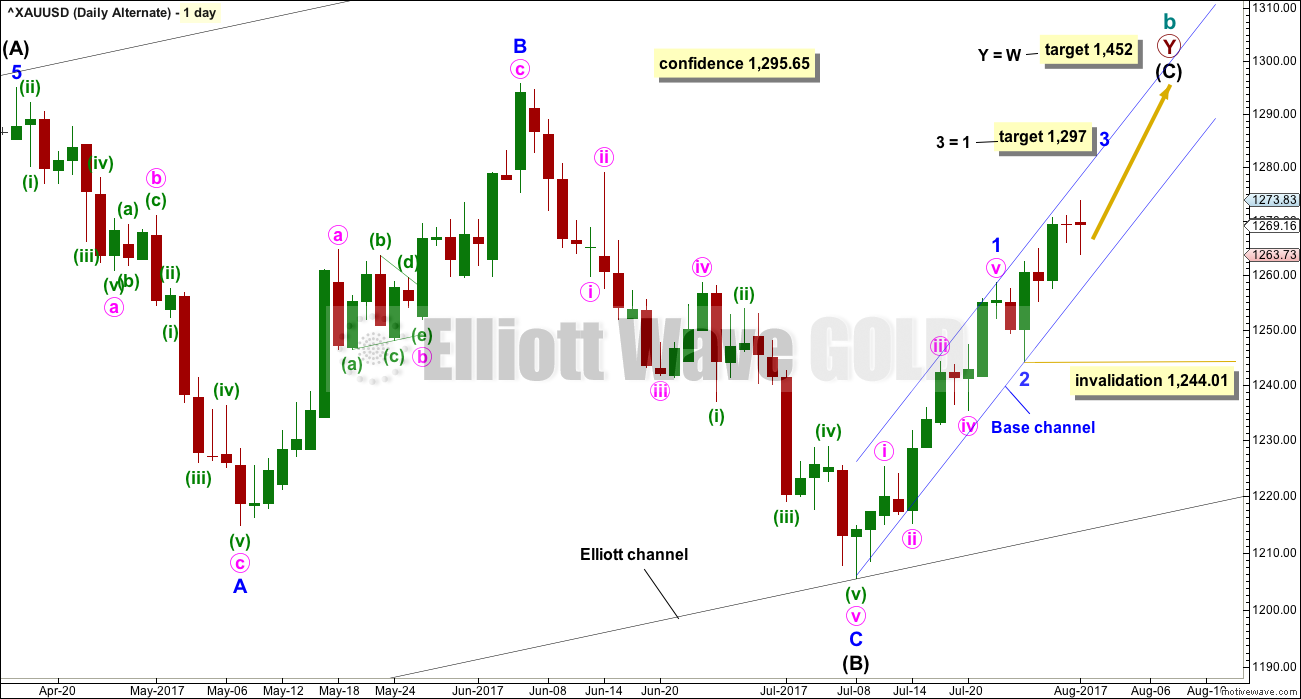
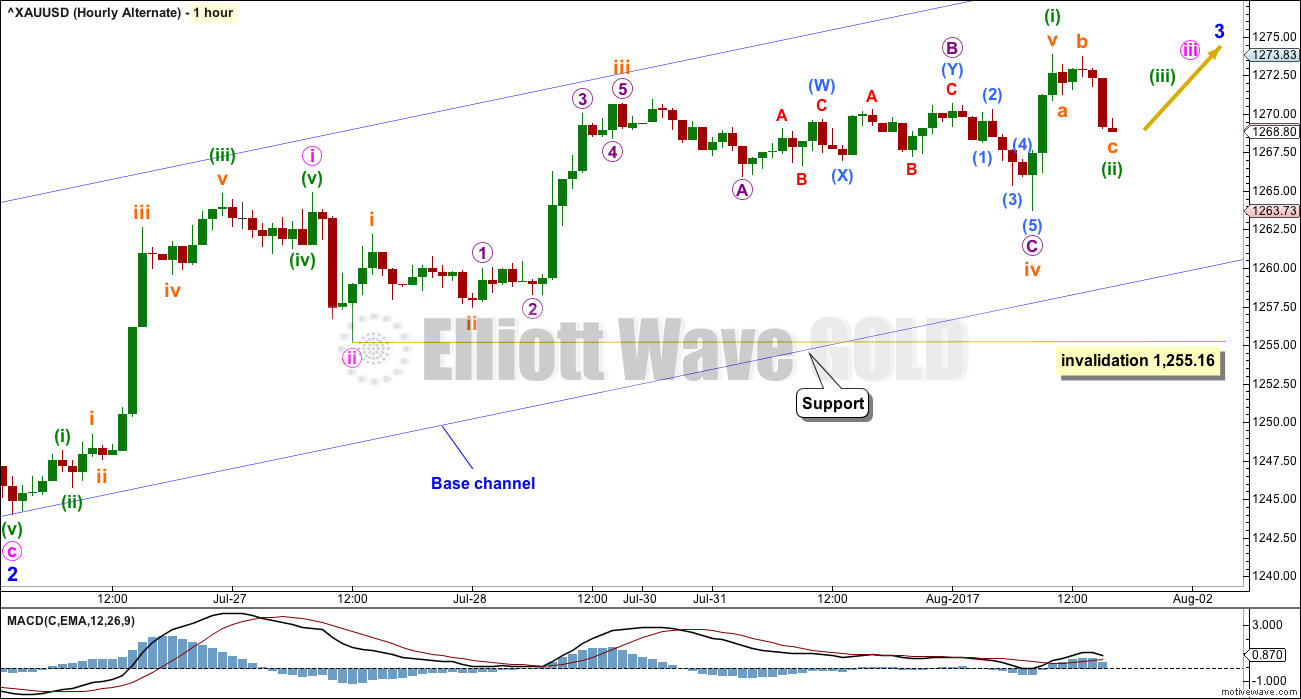
Massive plunge on this last hourly
candle. Are both hourly counts now
invalidated?
No. Not until price breaks below 1,255.16.
Was that drop in gold to 1256 the C wave, or wave 1?
appears the trendline has been breached. Gold looks to be moving up to the trend line.
There’s just way too much overlapping for an impulse now for minor wave C.
I don’t like this ending diagonal so much, they normally adhere well to their trend lines. This one has a small breach within minute wave iii.
However, it meets all EW rules regarding the structure. All sub-waves are zigzags, four overlaps one, trend lines diverge… that all fits.
Ending diagonals almost never have truncated fifth waves, so this count requires a new high. For wave five to meet the rule regarding wave length for an expanding diagonal it needs to be longer than 18.67. If it began at today’s low as I’ve labelled it then it needs to reach above 1,281.68. So that is our minimum target now.
I still can’t see a complete structure for minor wave C. Now, that does not mean it can’t be complete, I could have missed something and I could have gotten something wrong. I’ll keep looking to see what I could have missed.
Price remains within the blue channel which is our bottom line. When price breaks below the lower edge of that channel expect it’s likely we’ve seen a trend change.
And on a brighter note, I’m much better today. And so your analysis will be on time and done with a clearer head 🙂
Gold really trying to show it’s for real this time. Golds stocks not giving away the secret yet. I wonder if there will be a real breakout on Friday. It’s all about Friday
If price moves below 1,264.88 then I’d consider an ending expanding diagonal for minor C.
The trend lines must diverge, so minute iv has to move lower. Maybe bouncing up off the lower edge of the blue Elliott channel?
For a diagonal minute iv may not move beyond the end of minute wave ii below 1,255.16.
If 1,255.16 is passed in the next 24 hours then my hourly wave counts are wrong, the blue Elliott channel would be breached, and we would likely have a high in place.
Is it possible that the top is already in?
I’m ready to short gold and have no
desire to be long, whatsoever.
It’s possible, but so far I haven’t been able to see a complete structure for minor C.
It would be safest to wait for a channel breach before entering short. If the channel is breached, look for a curve up to test resistance, that may offer a nice entry point.
That set up requires quite a lot of patience though.
As GDX grinds higher in overlapping waves, it appears that an expanding ending diagonal may be forming to complete the move up for GDX. I’m afraid bulls expecting an upwards breakout are going to be disappointed.
Looking for the target range of 23.13 to 23.52 to be met in one or possibly two more days.
Lara, hoping you feel better soon!!!
https://www.tradingview.com/x/hS79lmqr/
A good looking wave count Dreamer. Thank you very much for sharing your work.
And thank you for the wishes for me to get better. I fervently agree with you. Can’t surf when I’m this sick!
If we have topped, was that sharp move up from 1269 to 1271 wave 2 of the down move?
Hi! Imo Gold price has not shown any signs of topping just yet; it appears bottomy for the week with 1263-62 currently holding and an upside move/rally in the making likely to target 1277-1286+ range. Long with a stop (and reverse?) at 1257-56…. GL; who is to say which way this will go; Silver showing signs of topping may lead the way!
USD/ JPY seems to be reversing, could mean that gold has topped already in IMO
1262 looks like it will be tested soon, I’m going short.
While that could work out very well for you, it is much more risky to try and pick a high then to wait for some confirmation by a channel breach.
If anyone here is going to try and pick this high please reduce risk to no more than 3% of equity. And always use a stop.